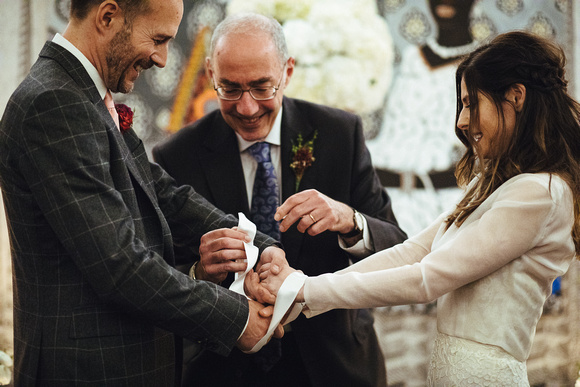
by Michael | Mar 5, 2019 | Blog
So what’s it all about?
I often get
asked what a handfasting is.
Do you remember when Prince William married Kate Middleton? Although the ceremony was religious, they briefly incorporated a ritual that resembled a handfasting. The Archbishop draped ribbons over the clasped hands of the couple.
So much else
was going on that it attracted little attention. In fact, a handfasting is
technically pagan, and can play a central role in pagan ceremonies.
However, it is often chosen as an “add-on” in a more traditional wedding.
A number of brides and grooms are intrigued by this and have decided to incorporate this in their wedding.
Of course, it can be included in a Vow Renewal too.
History
Handfastings
began as a marriage rite in the Middle Ages. When peasants married, they might
have been unable to afford a clergyman’s fee to hear their vows or a ring to
signify their love. The ritual of handfasting became a popular alternative.
A cord was wrapped round the wrists of the couple and left on until their union was consummated. It would usually be kept as a tangible reminder and proof of their commitment and love.
It has given
us the expression “tying the knot”.
Present-day Ceremony
Nowadays, the cord symbolises the pair’s mutual love. The way a handfasting can be slipped in to a service is as follows. Please note that this is only a suggestion, and it will be rather different for a pagan ceremony.
- Walking down the aisle to be given away by a parent
- Celebrant welcome
- Meaning of love (possibly from a religious slant, if that’s wanted)
- Here, or after the Handfasting, or at both times, a song or a reading/poem
- Handfasting
- Possibly, a Unity Candle or Sand Ceremony or Chalice ritual
- Exchange of Rings/Vows
- Jumping the Broom (not actually pagan, but deriving from wedding ceremonies conducted by slaves in the American South), now used to symbolise sweeping in the new as a new home is created
- Concluding words
Thoughts
I conducted a memorable handfasting at an Iron Age Fort in Wiltshire. The ceremony was part-pagan, part-Jewish with rituals from both sides. (Of course, the symbolism was explained as we went along.)
It was a
totally unique occasion – absolutely perfect for the couple and – clearly – for
the guests too.
Another
example was when I shared a wonderful experience with an American couple at
Stonehenge at the time of the solstice – and that was quite unforgettable!
Otherwise, I
have performed handfastings indoors, and they were just as satisfying!
To add extra sparkle and personality to your big day, do find out about a handfasting. It will be a pleasure for me to tell you more.
Photo: www.lyndseygoddard.com
Please check out my improved YouTube channel and subscribe! https://www.youtube.com/channel/UC1wWfxIZw0VpZLbHrJAbV6A?view_as=subscriber

by Michael | Oct 9, 2018 | Blog
Clearly, a lot of people really don’t know what a handfasting is. A few words of explanation shouldn’t go amiss, then.
A handfasting forms a central part in pagan ceremonies, but is often chosen as a colourful “extra” in a more traditional wedding. In that case, it may only last a minute or so.
Brief it might be, but it is something well worth considering.
History
Handfastings originated in Celtic times, but began as a marriage rite in the Middle Ages. When peasants married, they were often unable to afford a clergyman’s fee to hear their vows or to buy a ring to signify their love. The ritual of handfasting became a popular alternative.
A cord was wrapped round the wrists of the couple and left on them until their union was consummated. It would usually be kept afterwards as a tangible reminder and proof of their commitment and love.
This ceremony has, of course, given us the expression “tying the knot”.
Present-day Ceremony
Nowadays, the cord symbolises the pair’s mutual love. The way a handfasting can be slipped in to a traditional-type wedding is as follows, although this is only a suggestion, and it will be different for a full pagan ceremony.
This could be the order of service:
- Bride walking down the aisle with her father
- Officiant welcome
- Address about the meaning of love (possibly from a religious slant, if that’s wanted)
- Optionally, the couple’s ‘story’
- Here, or after the Handfasting, or at both times, a song or a reading/poem
- Handfasting
- Possibly, a Unity Candle, Sand Ceremony or Chalice ritual
- Exchange of Rings/Vows
- Jumping the Broom (not actually pagan, but deriving from wedding ceremonies conducted by slaves in the American South), now used to symbolise sweeping in the new as the new home is created
- Concluding words
Thoughts
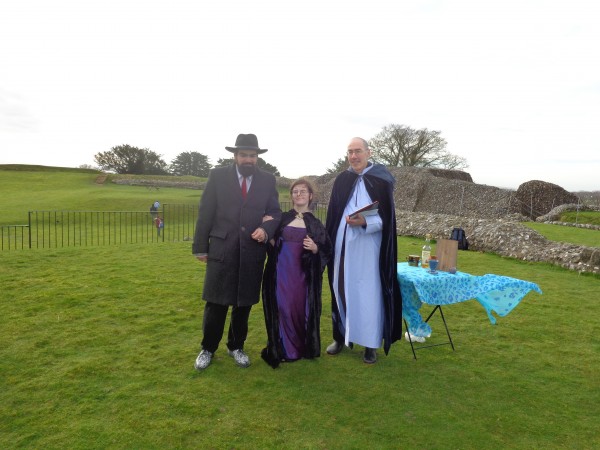
As a celebrant, perhaps my favourite handfasting was part-pagan, part-Jewish containing rituals from both sides. Of course, I explained the symbolism for those unfamiliar with the other’s practices, so everyone could understand. For example, the bride walked round the groom seven times while the groom recited his wife’s virtues (Jewish tradition), before we did the pagan handfasting.
This worked really well and helped create a warm atmosphere. It was a totally unique occasion – absolutely perfect for the couple and – clearly – for the guests too.
It’s something your civil celebrant will be able to advise you about.
If you want to add extra sparkle and personality to your big day, you could do a lot worse than try a handfasting.
Featured image: courtesy of www.lyndseygoddard.com
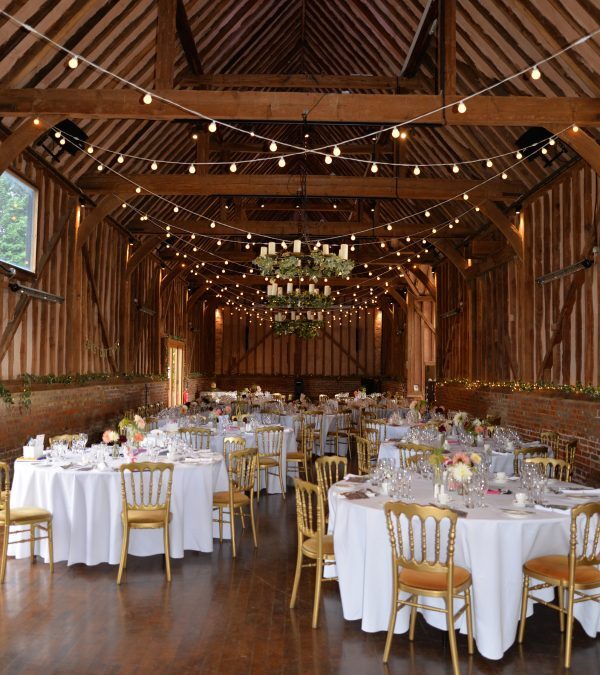
by Michael | May 14, 2018 | Blog
What a privilege! I’m so lucky, doing what I do. True, I don’t get to choose where I get to officiate. However, I end up at some glorious ceremony venues.
I could wax lyrical about many of them, in truth. However, I want to keep this to a manageable length, so will exercise self-restraint (for once).
Indoors
I loved the opulence of the Savoy. I thought the Oak Room at le Meridien hotel, Piccadilly, wonderful. Mill Hill Chapel was imposing without making you feel daunted. The winner, though, must surely be Lillibrooke Manor.
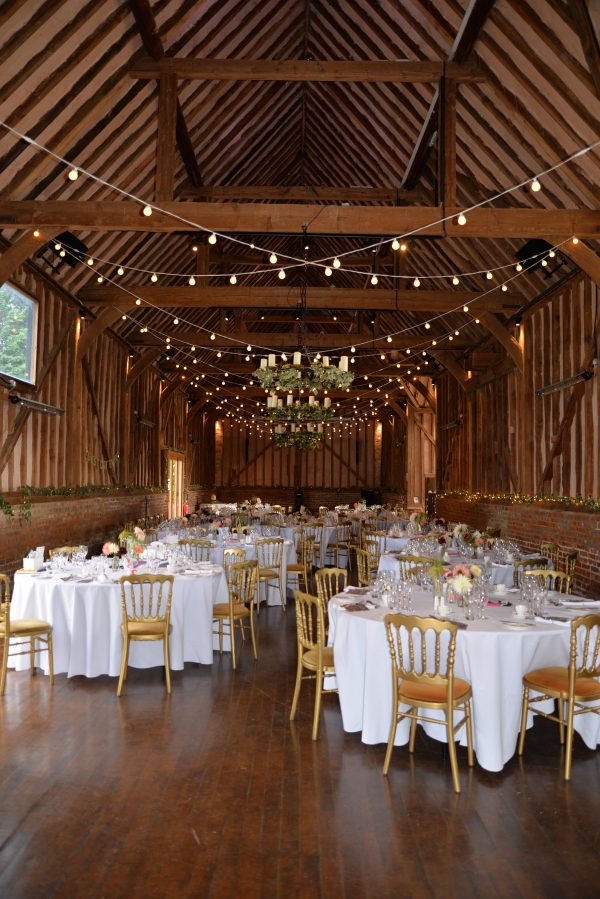
The Great Barn, Lillibrooke Manor
The current Manor House was constructed in about 1490, but the Great Barn is an unparalleled venue that is full of atmosphere.
Outdoors
Can you beat Stonehenge for an iconic setting?!
The day I conducted a ceremony there were Druids processing among the stones, so it made it even more special. I don’t know how you can top that.
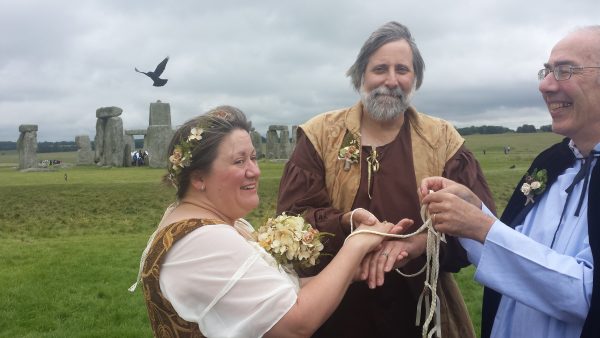
However, I was lucky enough to have a ceremony at Old Sarum. That is a lovely Iron Age fort overlooking Salisbury. This was actually my first wedding. I also remember it fondly because we avoided bad weather that January day.
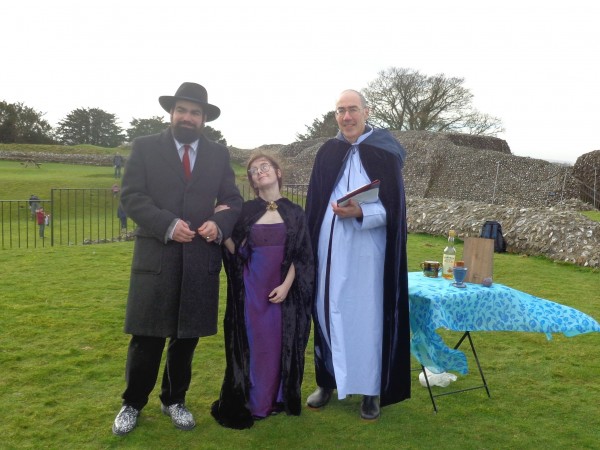
Finally, I assisted at a wedding at the Rollright Stones, in Oxfordshire. They are fairly remote and not particularly well-known. However, they are an impressive and atmospheric stone circle. They are pretty much complete and overlook a valley.
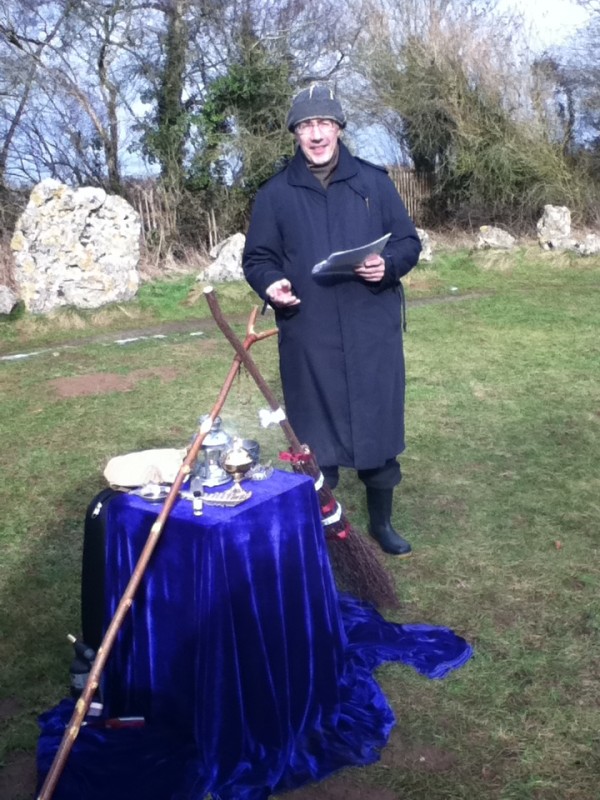
Perhaps the most stunning setting, though, came abroad, when I conducted a destination wedding at the Hotel Anassa, Cyprus. I have shown this picture below in several blogs, but make no apologies for repeating myself. It was glorious!
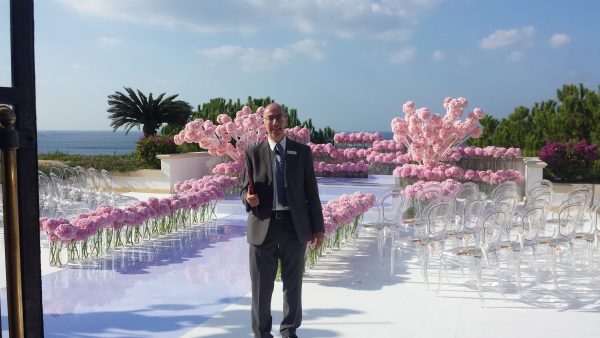
So which ceremony venues have you seen that have particularly struck you? Do please share them with me.
And if you’re planning a ceremony somewhere very special, I’d like to know about it too. (And if you want to take me there with you as your celebrant, I’d be more than interested to have a chat with you!)
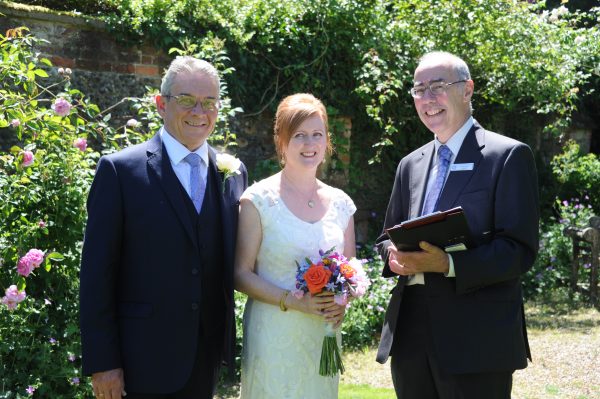
by Michael | Apr 16, 2018 | Blog
A lot of people ask me how I got into this profession. Most of them hadn’t heard of a civil celebrant before meeting me. In truth, I hadn’t heard the name either up until about six years ago.
So I had certainly never intended to become a civil celebrant!
Fate moves in mysterious ways.
Actually, if it hadn’t been for 400 prostitutes, I would never have known about the profession!
You may be feeling confused at this stage. But don’t get me wrong, please. Although I am still an active man, swimming is my main sporting activity!
So what’s this got to do with the prostitutes?
I had gone to a networking meeting, which featured a speaker. I didn’t know the title, which involved “400 prostitutes”. I just turned up. Well, I might have known the title, but had always planned to attend, you understand …!
Apparently, the speaker had considerable experience with prostitutes. He had made a fortune many years back by selling answering machines to a niche market nobody had tapped before: prostitutes!
After the presentation, I had a chat with him. It was an innocent chat, by the way! It turned out that he was a celebrant.
He told me that he helped people who wanted a ceremony that was bespoke – not formulaic. He worked with them to construct a ceremony that would mean the most to them (and, hopefully, their guests). It could be religious, semi-religious, non-religious – anything. It could be held anywhere – perhaps a licensed religious building, a hotel, a beach or a mountain top.
The ceremonies would be religious, or not, or partly so. They ranged from weddings, same-sex, vow renewals, baby-naming to handfastings. [No, I didn’t know what handfastings were at the time, either!]

Anyway, as I listened, I got drawn in. This was something different, this was exciting, this was something I could do well. I do engage with individuals – I listen well, write well and present well – the three major skills required! Here was something that would enable me to make a difference to others.
When could I start?!
Well, I trained late in 2012, and was sufficiently enthused that I then trained to become a funeral celebrant. Since then, I have conducted well over 100 ceremonies of different kinds – even one in Cyprus!

Who’d have thought that 400 prostitutes would have made such a difference in my life!
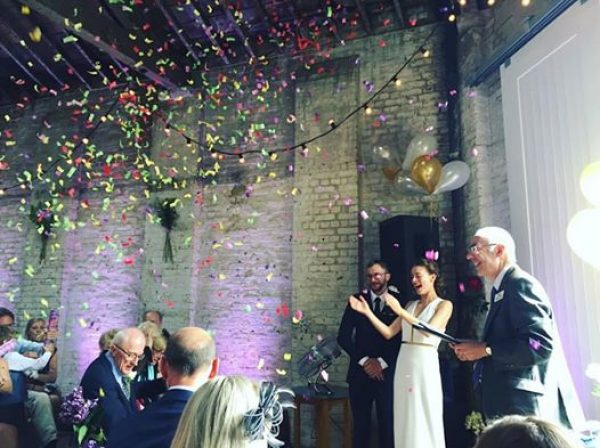
by Michael | Apr 13, 2018 | Blog
Your big day should be exactly that. So you should have the major input into who does what, where and when. It is your day, after all.
Religious
Why have your wedding in Church just because your parents insist? Religion may mean little or nothing to you. Moreover, you may prefer a rather less regimented affair.
Register Office
Most people assume that the only alternative is a Register Office wedding. If we’re honest about it, there’s something of the conveyor-belt about that. It can be sterile and mundane. Certainly not a very special or memorable way to mark your big day!
There is another path. How about this for an idea?
Another path
Make an appointment and go to the Register Office. It could be in the morning of your big day or the day(s) before. Turn up in your jeans, if you want, with two witnesses, and have the legal bit done. Then, afterwards, with the legal formalities over and done with, enjoy a celebrant-led ceremony in the venue of your choice. And when I say “of your choice”, you can actually be quite creative.
Venue
Climate may play its part, especially in the UK, but outdoors (gardens, beaches, moors) is certainly an option. So are stately homes, boats and plush hotels or more modest, but characterful, venues.
Celebrant
If you work with a celebrant, you can construct a wonderful ceremony. There may be no religion in it or just a dash (to keep the more conservative guests happy!) or even a combination of cultural religious elements.
You can decide what readings or poems to put in – and who is going to read them. The music programme is down to you, as is the dress code. Again, working with the celebrant, you can choose to have certain rituals included (maybe a handfasting, or drinking from a Loving Cup, or burning a Unity candle, for example).
So you and the celebrant can build a most meaningful and unforgettable ceremony that guests as well as you will remember and treasure.
You really don’t need to have the wedding you don’t really want!










